Prevalence and etiological factors of Piogenic Granuloma in gestants
DOI:
https://doi.org/10.14295/bds.2019.v22i4.1760Resumo
Introduction: Neglect with oral health and hygiene will be reflected in the accumulation of biofilm and possible formation of supra and / or subgingival calculus, one of the etiological factors of Piogenic granuloma (PG). Objective: To investigate the prevalence and etiological factors of pyogenic granuloma in pregnant women. Method: The study was carried out on 102 pregnant women attending prenatal care in Family Health Strategies. The oral examination of the gingival tissue of the maxilla and the mandible was performed to evaluate the presence of PG, according to Neville et al classification, gingival bleeding, poorly adapted restorations, supra gingival calculus and residual roots. The chi-square test (?2) was used to investigate the degree of association between variables. Results: Prevalence of PG was 1.96% (n = 2) in the third semester of pregnancy. No pregnant woman had received information about the condition during prenatal care. Regarding the quality of bucaL hygiene, in 63 pregnant women it was considered unsatisfactory, with plaque visible and supragingival tartar in both arches and satisfactory in 39, with supragingival tartar in the lingual of the antero-inferiors and in the vestibular face of the upper molars associated to plaque visible on all teeth. The chi-square test demonstrated a greater need for scaling and corono-root straightening and removal of residual roots when associated with the pregnancy condition. Conclusions: The prevalence of pyogenic granuloma was 1.9% during the third trimester of gestation. As an etiological factor, the presence of too much dental calculus and visible plaque in both arches was found in 61.7% of the pregnant women.Downloads
Downloads
Arquivos adicionais
Publicado
Como Citar
Edição
Seção
Licença
TRANSFERÊNCIA DE DIREITOS AUTORAIS E DECLARAÇÃO DE RESPONSABILIDADE
Toda a propriedade de direitos autorais do artigo "____________________________________________________________________" é transferido do autor(es) para a CIÊNCIA ODONTOLÓGICA BRASILEIRA, no caso do trabalho ser publicado. O artigo não foi publicado em outro lugar e não foi submetido simultaneamente para publicação em outra revista.
Vimos por meio deste, atestar que trabalho é original e não apresenta dados manipulados, fraude ou plágio. Fizemos contribuição científica significativa para o estudo e estamos cientes dos dados apresentados e de acordo com a versão final do artigo. Assumimos total responsabilidade pelos aspectos éticos do estudo.
Este texto deve ser impresso e assinado por todos os autores. A versão digitalizada deverá ser apresentada como arquivo suplementar durante o processo de submissão.




























